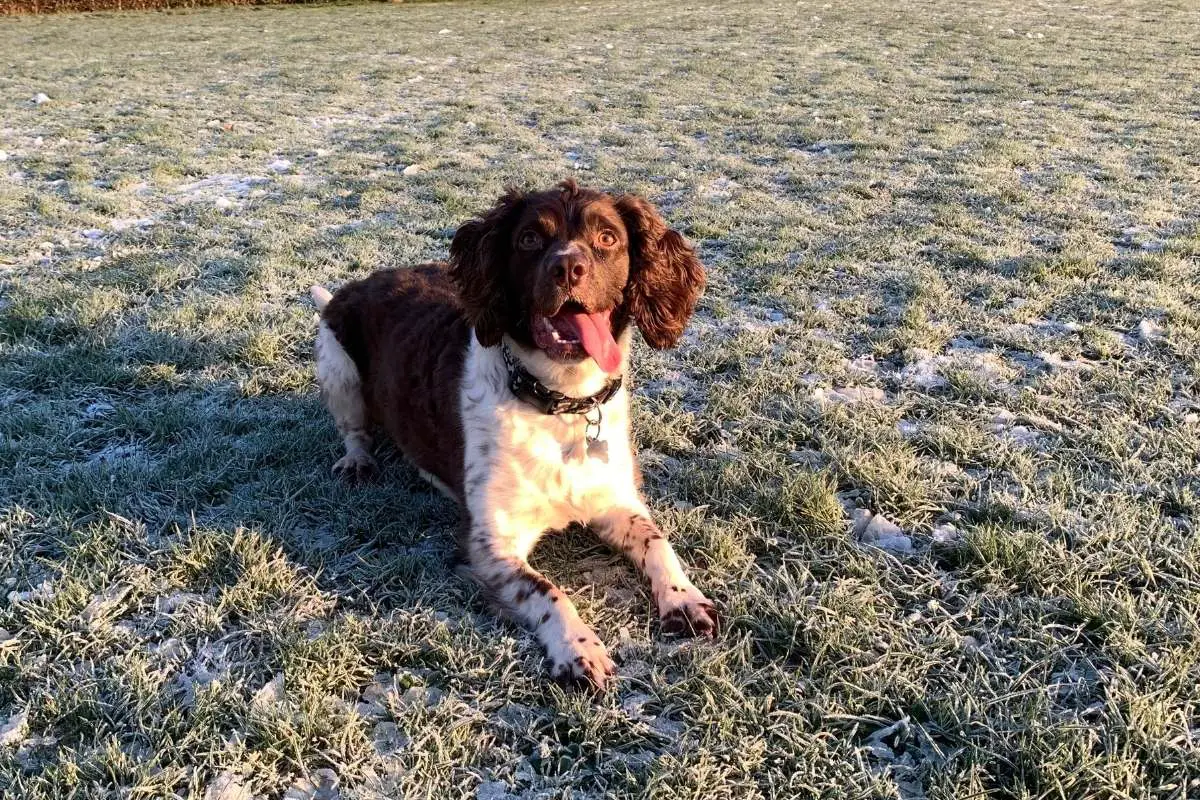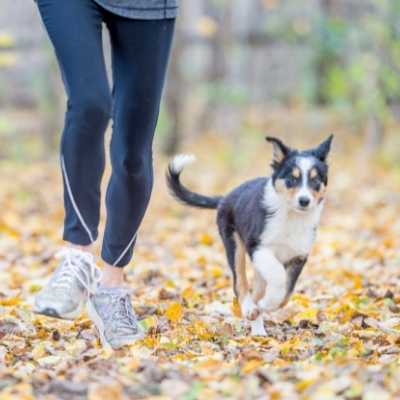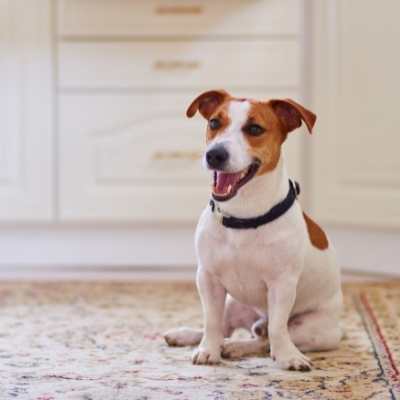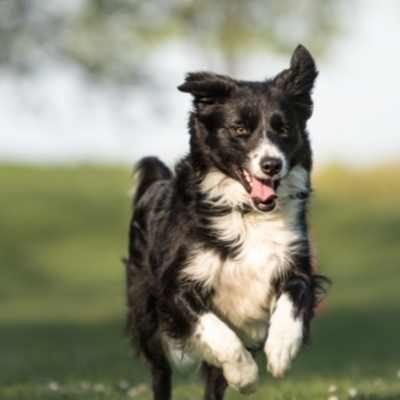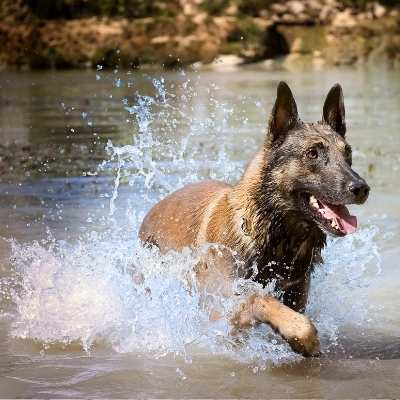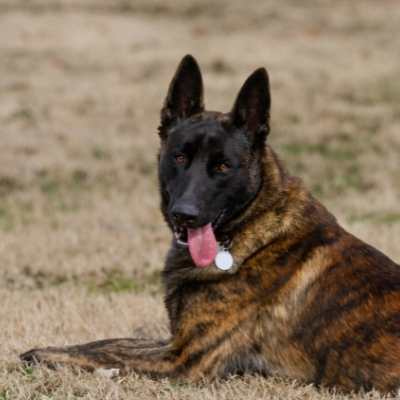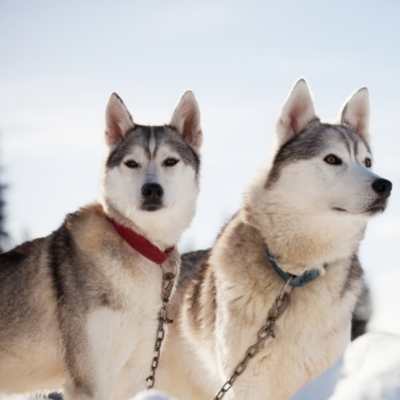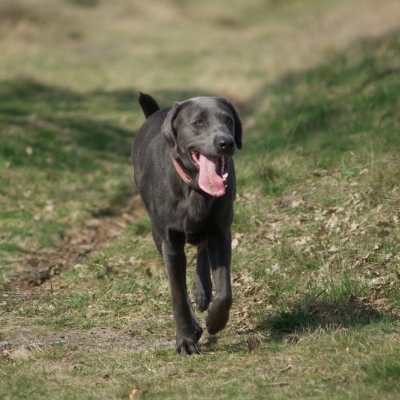I own a English Springer Spaniel called Bradley (that’s him in the photo!) Pounding the trail in the early morning with him is rewarding and invigorating. It is a great way to exercise and bond with him while I reap the rewards of all the exercise I’m getting at the same time. So what tips can I share about how to run with your dog?
Choose the right breed of dog and ensure your dog is in good health before running. Purchase suitable equipment and train your dog well. Establish a graded fitness program for your dog once it is old enough to begin running. Be aware that your dog may overheat.
I’ve been running with my dog for over 5 years and want to share with you some thoughtful information on the correct way to go about running with your best pal. It will look at suitable dog breeds, safety, equipment, and training.
Is It Ok To Run With Your Dog?
Running with your dog can be a rewarding and mutually enjoyable activity. Running with a dog has been shown to help reduce weight in both owners and their dogs. There are, however, various factors to contemplate when running with your dog:
- The breed of dog is important as you cannot expect certain breeds (e.g., a toy breed) to keep up with a human running.
- Factoring the age of the dog is essential.
- The health of the dog must be taken into consideration.
- The climate is a critical factor to consider.
- Your dog’s fitness level must be taken into account.
- Your running preferences – for example, do you run on the road or off-road terrain, and what distances do you like to run.
What Dogs Are Good Running Dogs?
There are some principles for choosing a dog to run with you:
- The dog should be athletic. Toy breeds will not be able to keep up with an adult human running for long distances. Heavyset breeds such as bull mastiffs will struggle to run with their owner.
- The coat of the dog must be considered. Long-coated dogs may get too hot if they are running in hot climates.
So what dogs make for good running partners…
Jack Russell Terriers And Fox Terriers
English Cocker Spaniels
English Cocker Spaniels can be couch potatoes, or they can have abundant energy. If you have an energetic Cocker Spaniel, you can take him or her running with you. Some Cocker Spaniels will have good endurance, and others will tire quickly and do better with shorter running distances. Cocker Spaniels with full long show coats will not cope well with heat control, and you will need to clip their coats. Cocker Spaniels bred from field lines will have shorter coats and do not overheat quickly during running. In general, it is probably best to complete only short runs with cocker spaniels.
It is important to note that American Cocker Spaniels have pushed in noses and are considered a brachycephalic breed and, therefore, not suitable for running.

Pointers, Weimaraners, Vizslas And Springer Spaniels
English pointers, German Wire-haired and Short-haired pointers, Weimaraners, Vizslas, and Springer spaniels are all dogs from the gun dog group. They are athletic dogs that were bred to spend a whole day out in the field hunting, so running with their owner should be an activity they enjoy. They all have short coats except for the Springer spaniel and so will not overheat during running. Springer spaniels with heavy show coats may need to be clipped to keep them cool enough during running. Springer spaniels with field coats should not need clipping unless you live in a scorching climate.
Rhodesian Ridgebacks
Rhodesian Ridgebacks are dogs with incredible stamina and muscles designed to run for miles. They have their origins in Africa where they were bred to hunt lions. Athletic prowess and endurance were a must for these dogs.
Setters
The English and Irish setters are lithe dogs used for hunting. They have good endurance and make easy running companions. Setters are seldom aggressive to other dogs or people, making them friendly dogs that do not cause trouble. Gordon setters have a heavier build than Irish and English setters. They may not be as good for running for extended periods.
Dalmations
Dalmations were used as hunting and carriage dogs. They ran next to horse-drawn carriages and horse riders in the seventeenth century in England. They were naturally alert and protective dogs and were used to protect travelers from highwaymen. During this same era, they became invaluably associated with fire coaches. Dalmations ran next to the horse-drawn fire carriage and protected the horses from interference by stray dogs and pedestrians. With a heritage like this, it is not surprising that Dalmations make good running companions.
Border Collies, Australian Shepherds, and Australian Cattledogs
Border collies, Australian Shepherds, and Australian Cattle dogs are known for their high energy levels, making them ideal running companions. They are lightly built and have good endurance for running long distances. You will need to ensure your Border Collie, Australian Shepherd, or `Cattledog is well trained as their herding instinct is strong. If these herders are not trained, they may nip at your heels which will be irritating and potentially dangerous as it could result in a fall. A well-trained Border Collie, Australian Shepherd, and Cattledog is a delight to run with, so it is well worth the time to train them.
Belgian Shepherd Malinois
Belgian shepherds come in four different types: the Groenendael, Malinois, Tervuren and Lakenois. The Belgian Shepherd most suited to running long distances is the Belgian Malinois. These short-coated dogs are highly athletic and will happily run with you. An important fact is that these are not dogs for novices nor ideal for pet homes. They are incredibly high-energy working dogs, and going for a run once a day will not meet their requirements for mental stimulation. They also need intensive training as they are naturally protective and will need to be taught to ignore other joggers and stray dogs. Laekenois may manage to be a jogging companion, but Tervurens and Groenendaels are not all natural runners.
Dutch Shepherds
Dutch Shepherds were bred to care for sheep all day and so have a lot of stamina. They are good dogs to consider as running companions.
Huskies And Alaskan Malamutes
Huskies and Alaskan Malamutes are dogs bred to run all day pulling a sled. They have tremendous endurance and will easily keep up as an exercise partner. Their thick coats prohibit them from running in hot climates. This is a serious consideration as dogs are not good at cooling down their body temperatures.
Salukis, Afghan Hounds, And Borzoi
Saluki, Afghan Hounds, and Borzoi are all sighthounds with good stamina that would enjoy running with their owners. They were bred to run long distances in the desert countries so can run in hotter climates.
Greyhounds
Although greyhounds are lean, athletic sighthounds, they are not long-distance runners. Greyhounds are best equipped for sprinting. If you like to run short distances at a fast pace, then a Greyhound is a good choice for you.
Labradors, Golden Retrievers and Rottweilers
Labradors, Golden Retrievers, and Rottweilers are usually not built for running long distances. If you want to run half a mile or a mile two or three times a week, then these dogs would probably cope, but their joints will be injured by running long distances.
Doberman Pinschers
Doberman Pinschers are short-coated, large breed dogs with boundless energy. Their athleticism makes them ideal dogs to accompany their owners on long runs on the road or off-road terrain.
How fast can dogs run?
How fast can a dog run versus a human runner?
It is worth baring in mind that most dogs are faster than humans. To put this into context, Usain bolt set a world record for the 100m in 2009 with a top speed of 23.35mph. So in this respect it isn’t a fair comparison for us mere mortal runners!
Dogs can generally run between 25-35 miles per hour for short distances. Speed and endurance differs between breeds, fitness and conditions.
But what about the specific breeds mentioned above? Check out the table below to see the maximum speed for dog breeds and a conversion to pace (min/mile and min/km)
[ninja_tables id=”918″]
What Dogs Should Not Be Running Companions?
Any of the brachycephalic dogs should not be allowed to run with their owners. Brachycephalic means ‘short head’. Brachycephalic dogs are dogs that have shortened muzzles – it looks like their noses have been squashed. An example of this is a boxer. Boxers may be athletic dogs, but they are not suited to running because of the shape of their faces. Brachycephalic dogs are prone to overheating and life-threatening breathing problems during extended exercise.
They suffer from Brachycephalic Obstructive Airway Syndrome, where the dog is unable to breathe out enough carbon dioxide. This compromises the oxygenation of the tissues in the body. The dogs collapse and die rapidly. Other dogs in this group include Pugs, English Bulldogs, French Bulldogs, some Bull Mastiffs, Boston Terriers, Shih Tzus, Lhaso Apsos, and Pekingese. Cavalier King Charles Spaniels (CKCS) and American Cocker Spaniels also have shortened faces and should not be exposed to strenuous exercise.
Heavyset or large dogs such as Bull Mastiffs, Great Danes, Newfoundlands, St Bernards, and Wolfhounds should not run with their owners. Their joints do not cope well with the repeated concussion that occurs during extended running. Giant and large breed dogs age more quickly than other dogs, and they become classed as senior dogs at approximately five years. Senior dogs, like senior people, can have heart issues which would make it dangerous to be involved in strenuous exercise.
What Age Can Your Dog Start Running With You?
Puppies, like human children, have growth plates in their legs that only close at certain ages. Exercising before these growth plates have closed is damaging to the bones in the legs and can cause irreparable harm to the dog. The rule is that the larger the dog, the longer it takes for the growth plates to fuse.
In giant breed dogs, the growth plates only fuse between eighteen months and two years.
Large breeds have growth plates that fuse between twelve to eighteen months. Medium breeds close at eight to twelve months and small breeds at six to eight months. There is individual and breed variation. If you have any worries, contact your veterinarian to discuss the issue.
I didn’t start running with my dog until after he was one.
At What Age Is A Dog Too Old To Run?
Dogs age at varying rates, depending on their size and breed. Giant breeds age a lot quicker (around five years), and small breeds take longer to age (eight to nine years). A dog that has been running regularly for most of his life will be fit and will probably be capable of running for a few years into the senior phase of his life. It is critical to monitor your dog closely and note any slowing down, reluctance to join you on the run, lameness, stiffness, or respiratory difficulties. Dogs that run with their owners should have regular veterinary evaluations as they enter their senior years.
Do not expect your unfit senior dog to begin running with you – even if you think it will help him lose extra weight. A walk is a more appropriate form of exercise for a senior dog, especially one that has never run with its owner previously. Veterinarians do not recommend a specific age that you must stop running with your dog. As your dog ages, you need to monitor its health closely and consult your veterinarian if you have any queries.
How to train your dog to run with you
Training your dog is essential when you begin running. You need your dog to be obedient on the leash and not pull and yank, or you will take a nasty tumble. Your dog also needs to learn to ignore other dogs and people and focus on you. Positive reinforcement training (such as clicker training) will obtain the best results in the most humane way.
Begin with a veterinary health check before you start exercising with your dog. Running is an intense cardio workout and is stressful on joints. Dogs need a complete health clearance before they begin jogging out with you. Just as humans must build up their fitness levels, so too must dogs. Begin by running short distances slowly. As your dog begins to easily cope with this, you can increase the speed and the distance. Plan your dog’s fitness program much the same as you would your own. Young dogs will adapt more quickly and have a natural level of fitness that will not be seen in slightly older dogs. You can progress through the fitness program faster with a younger dog.
Bryan Barrera has written a great book on how to run with your dog, this is a great place to start for how to start running with your dog. The book is called Running with Your Dog and is available on Amazon.
How Many Miles Can A Dog Run?
The question of how many miles a dog can run has no definitive answer as much depends on the breed of dog, the individual fitness level, the age, and factors such as heat control.
Most healthy, fit dogs can run between 2 to 5 miles comfortably. If you are doing longer distances than this, you will need to look for dogs that are extreme athletes that excel in endurance.
My own experience of this is that although my springer spaniel probably could run further, I tend to cap our runs at 5km. This varies depending on the weather, but it doesn’t exhaust him. I have to say that there is a noticable difference in him after a run, he’s more than happy to be quiet and sleep on the sofa!
A Health Check For A Canine Running Companion.
The heart and lung health of your canine running companion is vital. Heart murmurs can go undetected for many years if there are no veterinary health checks. Heart murmurs are asymptomatic but can cause issues during strenuous exercise, depending on the underlying cause.
Heartworms are caused by Dirofilaria immitis, which is transmitted through the bite of mosquitoes. Heartworm causes severe heart and lung damage. Owners may not notice it in the early stage of the disease. The medications used to treat heartworm can cause clotting, and a dog should not be exercised while being treated for heartworm. There is a risk of stroke or heart attack. The veterinarian will advise you if there has been significant damage to the heart and if your dog can engage in vigorous exercise.
Spirocerca Lupi are red worms that infect dogs when they ingest dung beetles or birds, chickens, mice, lizards, or frogs. Spirocerca Lupi cause neoplastic nodules or tumors in the esophagus, gastric wall, or wall of the thoracic aorta. These nodules cause significant damage and can affect the functioning of the heart. Breathing can be affected if the esophageal nodule is large enough to impinge on the trachea. Your veterinarian will assess your dog for spirocerca Lupi infection prior to exercise.
Joint health is essential for running companions. Any joint dysplasia will contraindicate running for any distance other than around the yard. The hind and forelimbs must both be checked as dysplasia can occur at both the hips and elbows. Joint arthritis will also prevent the dog from being a running companion.
Can A Dog Overheat From Running?
Dogs are not efficient at cooling themselves down if they overheat. Hot and humid climates will result in a dog quickly overheating. This is of special concern for dogs with long or thick coats, such as Huskies or Alaskan Malamutes. If you reside in a place with high temperatures, it would be best to choose a short-haired dog and avoid running at the hottest times of the day. It would be best to run with your dog in the early morning or late afternoon..
Overheating is one of the biggest health concerns when running with your dog. Canines do not sweat through their skin as humans do. They lose body heat by sweating through the pads on their paws or panting with their mouths open. Although this can cool them down, it is not a quick or efficient method.
Signs of a dog experiencing heat stroke (overheating) include the following:
- Respiratory difficulties
- Rapid heart-beat.
- Excessive panting.
- Drooling
- Intensely red gums and tongue.
- Dry gums or skin that, when pinched up, does not return to its normal position in the appropriate time.
- Staggering or uncoordinated gait.
- Weakness
- Nausea and vomiting.
- Diarrhea – often bloody.
- Confusion
- Collapse
Before running with your dog, always check the heat of the road surface. Hard artificial surfaces heat up considerably in the sun and can cause burns and blistering on the pads of the dog’s feet. Running at cooler times of the day will help prevent this. The dog can also be fitted with dog boots to protect the feet from burns.
It’s always worth considering if there will be water available on your run (like a stream). If not it may be worth considering how you can carry some for your furry friend. If i’m taking water myself, I tend to take a rubber collapable bowl like this one from Amazon. It’s lightweight and clips onto the dog harness.
What Is The Best Running Surface For Dogs?
Running on natural surfaces such as grass are the best running surface for dogs. Running on roads and pavements increases the concussive forces on joints of both humans and canine runners. Natural surfaces such as grass or sand are much kinder to joints and prevent injuries and joint breakdown.
Off-road or wilderness running will require a dog that is in the upper levels of athleticism and endurance. Trails in these areas tend to be longer, and the dog will need to be fit enough to cope with the length and the different inclines that may be present on the trail.
If you live in freezing, snowy, or frosty climates, your dog may need dog boots to prevent its feet from getting frostbite.
What Equipment Do You Need To Run With Your Dog?
A simple collar and lead may not be the best option for running with your dog. A sudden stop when traveling at speed will pull on the dog’s neck and could cause damage to the larynx and trachea.
A dog harness and belt attached to the runner are the best equipment to run with your dog. The harness protects the dogs neck while the belt allows the runner to pump both arms while running. Dogs may also benefit from wearing dog shoes on harsher surfaces such as hot tarmac or ice.
Dog Running Harnesses
A harness is a better idea as the lead is attached so that it will pull on the dog’s chest. As humans run, we tend to move our arms, pumping them to give extra impetus and balance. Running with a lead in your hand could pull unnecessarily on the dog, causing him to stumble or lose his balance and potentially causing injuries. There are belts that the human runner can wear that allow for the lead to be attached to them, freeing up the owner’s hands and arms. This is usually a safer option as you are unlikely to drop the lead.
[ninja_tables id=”928″]
Dog Shoes
Dogs that run on hard surfaces such as asphalt, concrete, or gravel may benefit from being fitted with dog shoes. The New York Times reviewed dog boots, and if you are interested in exploring this option, you can read their article here.
Their recommendation for the best dog boots was the All-weather Muttluks, which you can buy on Amazon
If you use clicker training, then you will need a clicker and treat bag. Something like the OllyDog Goodie Treat Bag (buy it here on Amazon) is good for this as it has a magnetic top to stop treat flying out while you are running.
You may want to consider a harnessd and leash. My advice from experience is make sure that the waistband has padding and that the leash has some kind of stretch in it. This will save you any pain from rubbing if you have a dog that likes to pull on a lead.
How To Run Safely With Your Dog.
It is crucial to ensure that you and your dog are safe. Some people do not like to have their dog on a leash while running. Many states or counties have leash laws that require your dog to be leashed when in a public space. Off-leash running presents more dangers as the dog could be involved in a traffic accident, be attacked by other dogs, or become lost. A surprising number of dogs fall to their deaths when accompanying their owners on trails bordered by steep cliffs or precipices.
Keeping your dog attached to a leash is the safest way to run with your dog. The lead can be attached to a belt at your waist to free up your hands. Ensure that your dog has obedience training and will respond reliably to your commands whether you run with it off-leash or on leash. A dog that is close to your side will offer you more protection from criminals who might try to attack you. There has also been a trend in the last year to snatch dogs off the street. If your dog is close to your side, this is less likely to happen.
Etiquette When Running With Your Dog.
When running in country areas, it is essential to ensure that your dogs do not chase any livestock. Most countries have laws that allow landowners to shoot stray dogs that endanger or harass their livestock. Keeping your dog away from livestock protects your dog as well as the livestock.
Ensure that your dog is well socialized with other dogs and people. It is scary and intimidating for most people to be approached by a large unknown dog, even if its intentions are friendly. Fighting with other dogs could result in you being fined and responsible for any veterinary bills for your dog or the other dog as a result of the fight.
Conclusion
Running with a canine companion can be a wonderful experience and allow you to bond closely with your pet. It is vital to choose the correct dog to run with you. Not all dogs are naturally athletic enough to cope with extended running exercise. Your dog should have a health check before running. The dog must be trained to be socially appropriate when taken out in public. Good training also keeps you safe as you will be less likely to fall if the dog knows how to run by your side and is not pulling you over. A dog trained to run by your side deters potential criminals or wildlife that may harm you or the dog. Monitor your dog’s health closely and consult a veterinarian if you have any concerns. Happy running with your best canine friend!
References
American Kennel Club. Belgian Malinois. https://www.akc.org/dog-breeds/belgian-malinois/
American Kennel Club. Dutch Shepherd. https://www.akc.org/dog-breeds/dutch-shepherd/
American Kennel Club. What was the Dalmation Bred To Do? https://www.akc.org/expert-advice/lifestyle/dalmation-breed-facts/
Anastasio, A. 2018. Dog Breeds That Could Make Good Running Companions. AKC. https://www.akc.org/expert-advice/health/best-running-dogs/
FDA. Keep the Worms Out of Your Pet’s Heart! The Facts About Heartworm Disease. https://www.fda.gov/animal-veterinary/animal-health-literacy/keep-worms-out-your-pets-heart-facts-about-heartworm-disease
Fitzpatrick Referrals. Brachycephalic Obstructive Airway Syndrome (BOAS). https://www.fitzpatrickreferrals.co.uk/soft-tissue-service/brachycephalic-syndrome/
Peregrine, A.S. 2014. Spirocerca Lupi In Small Animals. https://www.msdvetmanual.com/digestive-system/gastrointestinal-parasites-of-small-animals/spirocerca-lupi-in-small-animals
Von Pfeil, D.J.F. and Decamp, C.E. The Epiphyseal Plate: Physiology, Anatomy, and Trauma. https://vetfolio-vetstreet.s3.amazonaws.com/mmah/48/37155337d24e34963af2fc8e4cdce3/filePV0709_Von-Pfeil_P1.pdf
Wells, K. 2018. The best dog boots. New York Times. https://www.nytimes.com/wirecutter/reviews/best-dog-boots/

